














In our household, we refer to Ken as the house whisperer. He transformed our home, which I never thought was particularly special, into something extraordinary in just a few days. As a result, it sold for more money than I ever dreamed possible, and all within a matter of days. Ken truly knows his stuff and is at the top of his game.
If you're serious about selling your house, he's the agent you should call. - CT

in
scan

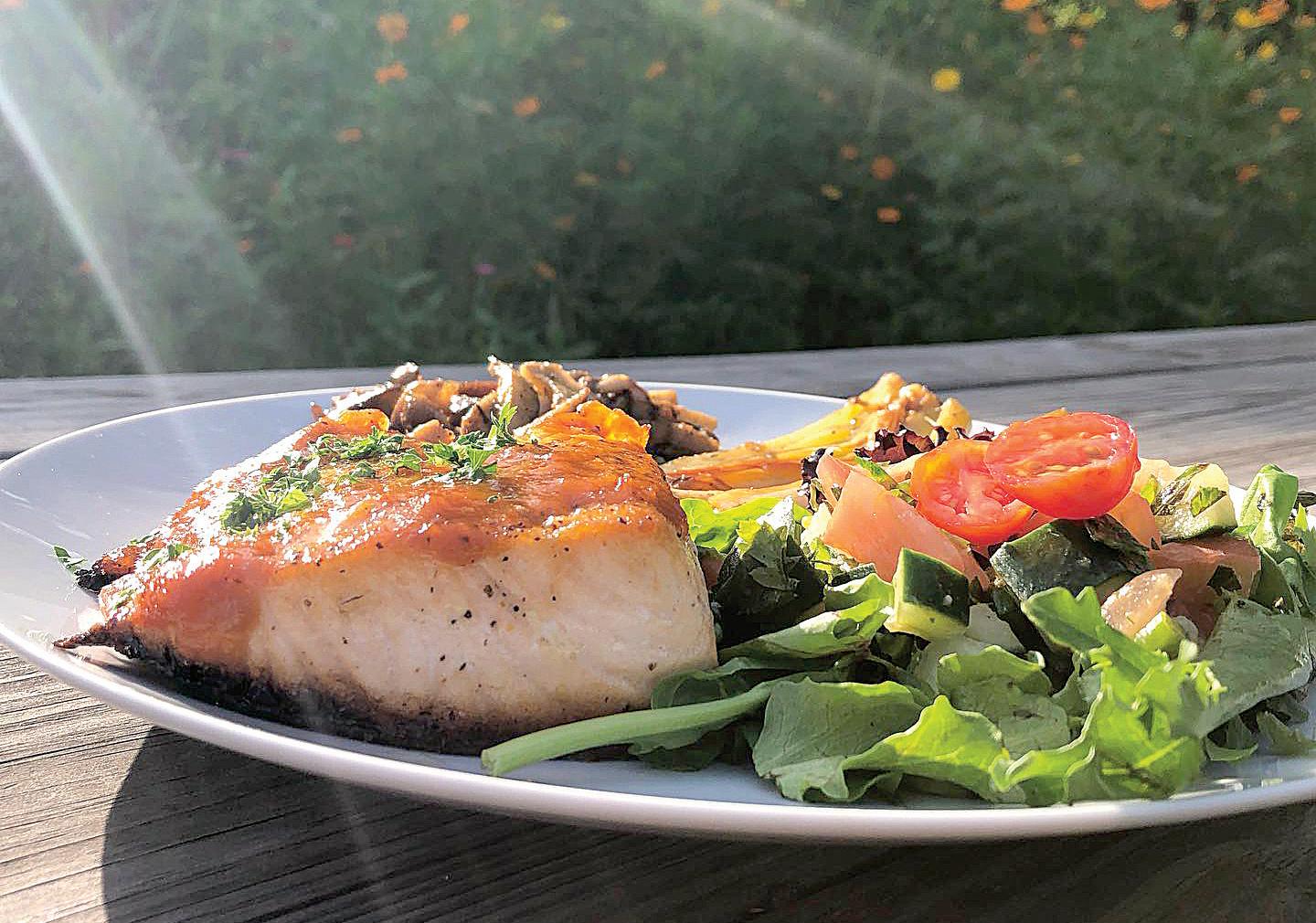

Editorial
Collin Kelley
Editor collin@roughdraftatlanta.com
Beth McKibben
Senior Editor, Food & Dining
Sammie Purcell
Associate Editor
Staff Writers
Dyana Bagby
Cathy Cobbs
Bob Pepalis
Logan C. Ritchie
Contributors
Sally Bethea, Kathy Dean, Jan Schroder





In the summer of 2011, Atlanta Intown collaborated with writing students at the Savannah College of Art & Design (SCAD) to produce a special issue filled with their reporting and features. As part of Intown’s 30th-anniversary celebration, we decided to do it again.
While the stories in the previous version were more eclectic in nature, a theme was suggested for this collaboration. This month is the 60th anniversary of the passage of the Civil Rights Act of 1964, and since Atlanta is the cradle of the Civil Rights Movement, it felt like a way to acknowledge history as well as explore the impact of the landmark legislation.
Over several months of conversations and meetings with the students in Paige Gray’s writing class, this special section
show just how much more work needs to be done to fulfill the dream of civil rights for all.
I hope you will take time this month to read not only the stories included here (starting on Page 29) but also a larger body of work created by the students at our website, RoughDraftAtlanta.com.
Along with our SCAD collaboration, I’m excited that we’ve partnered once again with Central Atlanta Progress for a special section on all the summer fun to be had in the Centennial Olympic Park District in Downtown. Whether you’re a native, newcomer or visitor, there are things to see, do, and eat that are worthy of your time and curiosity. This section starts on Page S1.
Longtime readers of Intown might also recognize a familiar byline on this month’s travel story (Page 42). Jan Schroder was my predecessor as editor of Intown more than 20 years ago. I’m tickled that she’s back in our pages as we mark a big anniversary.






evolved into an examination of how the Civil Rights Act continues to provide opportunity and equality while also looking at its failings and ongoing challenges.
Civil and human rights are driving much of the debate and conversation during this fraught presidential election year, so the features on Global Black Pride coming to Atlanta, the advancement of women in sports, successful Black entrepreneurs, and art as activism are timely and of the moment.
Inequity is also a theme here, with the struggle of gig workers to make ends meet, the ongoing threat of book bans to stifle knowledge and diversity, and even the challenges baseball legend Hank Aaron faced after his historic home run
Another longtime contributor, Kathy Dean, is also back this month with a mid-year report on Atlanta home sales (Page 38) as first-time buyers sit on the sidelines hoping for lower interest rates. As a condo owner myself, I hate to see that sales are stagnant and properties are lingering on the market. Just three years ago, condos were being sold in a matter of days – or hours – as I discovered on my home search.


The Impact of the Civil Rights Act on its 60th Anniversary
I also wanted to close by saying thank you to everyone who came out to the book launch for my new poetry collection, “Wonder & Wreckage,” and those who have bought copies online, at a bookshop, or directly from me. I have more readings (virtual and live) coming up this summer and into the fall, so check out my website at collinkelley.com to see where I’ll be next.













 By Dyana Bagby and Collin Kelley
By Dyana Bagby and Collin Kelley
A resident advisory council voted overwhelmingly against supporting Portman Holdings’ proposal to redevelop Amsterdam Walk at its May 15 meeting.
Members of Neighborhood Planning
Unit F voted 282-84 against the developer’s plans to raze the existing structures of Amsterdam Walk, a small-scale shopping center, to make way for hundreds of apartments, an office building, plazas, and retail. The site is prime real estate adjacent to the Atlanta BeltLine and nestled between



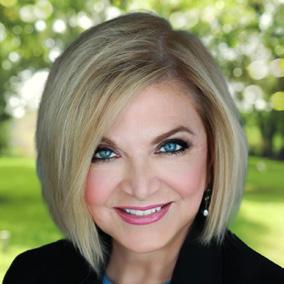



the Virginia-Highland and Morningside neighborhoods.
The battle over the development has been brewing for months in the neighborhoods and in recent weeks, concerns were raised by some residents about Portman’s opposition to light rail transit on the BeltLine.
The NPU-F vote came a day after both the Morningside Lenox Park Association (MLPA) and VirginiaHighland Civic Association (VHCA) voted in favor of the redevelopment plan.
Portman agreed to 39 zoning conditions to gain approval by the neighborhood associations, including reducing the heights of the office building from 13 to eight stories and the apartment high rise from 15 to 13 stories. The number of apartments proposed is now 840, instead of 900. The project still includes 1,400 parking spaces.
At the MLPA meeting, Portman Senior Vice President of Development Mike Greene asked board members not to consider his or Portman’s stances against light rail transit on the BeltLine, specifically extending the Atlanta Streetcar from Downtown to the Eastside Trail.
He also acknowledged his and the company’s participation with the Better Atlanta Transit coalition to lobby city officials to squash the light rail project and look at other transit options, like bikes, scooters, bus rapid transit, and autonomous vehicles.
However, it was clear at the NPU-F meeting that many residents couldn’t ignore Portman’s opposition to light rail. Many people voiced their concerns about the amount of vehicle traffic the development would put on Monroe Drive and residential streets.
In an interview days before the vote, Kay Stephenson, a 28-year resident of Virginia-Highland, said the neighborhoods would benefit from the redevelopment of Amsterdam Walk.
“We do need more density. There’s no question about that. We need housing and we especially need affordable housing,” she said. “That’s where density makes sense — if you’re on the BeltLine, where we’re going to have transit.”
Stephenson said she and other neighbors agree it makes no sense for Portman, or any developer, to build a large project on the BeltLine while opposing light rail transit.
“It was clear to me Portman was going to try and kill transit,” Stephenson said. “Transit on the BeltLine is the linchpin that makes it work. I just don’t
see any way for the Amsterdam Walk development to work if everybody is coming and going from it in a car.”
Mark Arnold is an architect who has lived in Virginia-Highland since 1996. He also supports the redevelopment of Amsterdam Walk with higher density because of its proximity to the BeltLine and Piedmont Park. But not by a developer that wants to take away transit, the key component of Ryan Gravel’s Georgia Tech master’s thesis that is now one of the country’s largest urban revitalization projects.
“I don’t think any of the new projects that are increasing density under the guise of the BeltLine overlay district should be allowed to continue forward unless there’s a firm and real commitment to the transit component,” Arnold said.
Neighborhoods that border the BeltLine had their zoning changed to accommodate transit-oriented density because of the promise of light rail transit on the BeltLine. Most of the right-of-way along the 22-mile Beltline loop around the city’s urban core has been purchased for light rail transit. Voters approved a sales tax in 2016 to fund light rail.
Now that developers have miles of “beachfront property,” and the building of light rail is about to begin, they don’t want transit, Arnold said. Projects like Amsterdam Walk should not be allowed to move forward without the promise of light rail and city leaders should not “kowtow to the NIMBYism,” Arnold said.
“Their backyard came with the promise that there will be transit on the BeltLine. And that’s what we should have,” he said.
Whether MARTA and Atlanta BeltLine Inc.’s original plan to extend the Atlanta Streetcar from Downtown to Ponce City Market along the Eastside Trail is now uncertain.
In an interview with Atlanta News First, Dickens revealed he wasn’t sold on the idea of extending the Atlanta Streetcar to Ponce City Market, which MARTA currently has in the planning stages. “Do we want it to be on rails, do we want it to be on rubber tires, do we want small pods or do we want to leave this as a walking trail?” Dickens said.
Instead, the mayor has touted four new MARTA stations as ways to create more access to the BeltLine.
Portman’s plan now goes to the city of Atlanta where it will face scrutiny by the zoning review board and comprehensive development review committee before the city council takes final action.








A new superintendent for Atlanta Public Schools is expected to be chosen by this fall, and not July 1 as originally planned. The extension was made after school board members learned the names of some candidates were made public — a violation of the process.
The on-again, off-again Music Midtown festival is off again for 2024. The organizers posted on social media in May that the Piedmont Park festival, usually held in September, was going on “hiatus.”
The May 21 Georgia primary ran smoothly, with Democrats and Republicans setting up their candidates
The Georgia Department of Transportation announced it will add toll lanes to the top half of I-285 and along Georgia 400 to the North Springs MARTA station.
The Atlanta City Council approved a resolution in May to make sure historic preservation is part of the redevelopment of the Atlanta Civic Center property. The concept includes multiple residential high-rises, a hotel office building, retail, and reuse of the Civic Center Performing Arts Center.

for the general election this fall. However, a few key races will face a June 18 runoff, including who will be the next DeKalb County CEO.







Here is a list of metro winners and runoff candidates:
DeKalb County CEO – Runoff
Lorraine Cochran-Johnson 46.3
Larry Johnson 34.4%
DeKalb County Commission
District 1
Robert Patrick
Fulton County Sheriff
Pat Labat
Fulton County District Attorney
Fani Willis, who will face Republican challenger Courtney Kramer in November.
Fulton County Clerk
Che’ Alexander
Fulton County Commission
District 4 – Runoff
Natalie Hall 41.56%
Mo Ivory 40.62%
Fulton County Commission
District 6
Khadijah Abdur-Rahman
Fulton Superior Court Atlanta
Judge Scott McAfee
Georgia Supreme Court
Andrew Pinson
State
State House District 42 Gabriel Sanchez
State House District 90
Saira Draper
Atlanta MOST
Voters overwhelmingly supported renewing the one-percent sales tax for water and sewer projects in the city of Atlanta.
Mulberry Cityhood Voters in Gwinnett County approved the incorporation of Mulberry, which will become the county’s second-largest city.
For more information about the upcoming runoff and general election, visit fultoncountyga.gov or dekalbvotes.com.




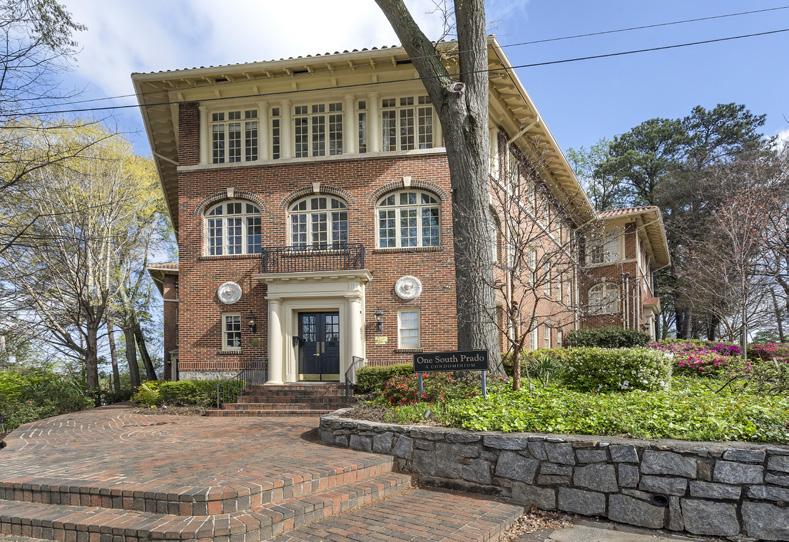











Congratulations, graduates! Metro Atlanta families gathered in May to celebrate the graduating class of 2024. Here are the top students honored as valedictorians and salutatorians for local public and private schools.
Atlanta Public Schools
Atlanta Classical Academy
Andrew Heiskell (V) and Lauren Woods (S)
Benjamin E. Mays High School
Forrest Cherry, III (V) and Mishayla Dunlap (S)
B.E.S.T. Academy
Emery Jones (V) and Joshua Salami (S)
Booker T. Washington High School
Kash Walton (V) and Brooke Shelton (S)
Charles E. Drew
Charter School
Morgan Walker (V) and Frances Nicolson (S)
Coretta Scott King YWLA
Amariah Caudle (V) and Christina McKelvey-Fludd (S)
Daniel M. Therrell High School
Treyven Jamison (V) and Imani Stover (S)
Frederick Douglass High School
Dontavious Blount Jr. (V) and Chanel Sanchez (S)
George W. Carver Early College
Aynia Grimes (V) and Christina Perry (S)
George W. Carver STEAM Academy
Kiarra Horton (V) and Kamaria Anderson (S)
KIPP Atlanta Collegiate
Kenedie Upshaw (V) Syania Brown (S)
Maynard H. Jackson High School
Liam Smith (V) and Samuel Finlayson (S)
Midtown High School
Shalin Bhatia (V) and Delia Schroeder (S)
North Atlanta High School
Jane Heller (V) and Miah Chien (S)
South Atlanta High School
Zachary Davis (V) and Meilyn Motino (S)
DeKalb and Fulton County Schools
Chamblee High School
Jack Bolte (Magnet Valedictorian), Joshua Jacks (Magnet Salutatorian), Hanna
Lin (Resident Valedictorian), and Kai Henderson (Resident Salutatorian)

Maia Asman
Ross Bernstein Eli Bier
Caleb Blank
Jayden Block
Judd Brown
Hilley Buhnik
Dylan Cahill
Dylan Carlin
Jake Carlin
Liam Dardik
Jace Dishner
Micah Dresdner
Luana Etchechoury
Anna Feldman
Mindy Feldman Ileana Galanti
Eleanor Ganz
Hannah Garton
Spencer Godwin Fiona Greenbaum
Sarah Greenbaum Lily Greenstein
Rachel Jacobson Benjamin Jannett
Kira Kaplan
Sydney Kramer Ella Lazarian Asher Leder
Macune
Jeremy Mager
Alexa Maslia
Ilan Milrud
Sophia Molinari
Lauren Moradi
Liza Moradi
Matilda Mundell
Maya Nebel
Halle Nelms
Sophia Nowak
Thomas Oken
Owen Peretz
Daniel Richman
Avana Saitowitz
Tatum Sasine
Lilah Scher
Sydney Serotta
Ben Slipakoff
Rebecca Sobel
Jack Solomon
Charlotte Spector
Ryan Srochi
Elliot Sturisky
Mitzi Thaler
Sydney Tolk
Ethan Topor
Anna Vaynshteyn
Jacob Viente
Emme Yudin
Charlie Zell
Cross Keys High School
Exhale Castaneda (V) and Floricela Bravo-Avendano (S)
Decatur High School
Gordon Lichstein (V) and Alexander Gurch (S)
Druid Hills High School
Terry Crawford (V) and Micah Burton (S)
Dunwoody High School
Neil Shah (V) and Naomi Kleber (S)
FCS Innovation Academy
Lakshana Ramanan (V) and Tanih Potula & Vihaan Narvekar (S)
Fulton Academy of Virtual Excellence
Andy Qu (V) and Brea Butler (S)
Global Impact Academy
Cyr Kamga (V) and Isabela Damian (S)
Independence High School
Myles Estime (V) Jasmine Valle (S)
Lakeside High School
Shreya Chatterjee and Matthew Phillips (V) and Zachary Murphey (S)
North Springs High School
Christopher Yamamoto (V) and Aoi Chiara Misawa (S)
Riverwood International Charter School
Leah Perlman (V) and Ava Satisky (S)
Tapestry Charter School
Bethlehem Gidey (V) and Richard Holloway, Jr., Bram Rosenblatt, and Violet Todd (S)
Tucker High School
Epherata Zeleke (V) and Ava-Elizabeth Jacoby (S)
Private Schools
Atlanta Jewish Academy
Zellik Silverberg (V) and Asher Lytton (S)
Holy Innocents' Episcopal School
Colin Welden (V), and Hun Chi (S)
Holy Spirit Preparatory School
Alexia Riley (V) and Marlyn Pineda (S)
The Lovett School
Helen Darby Sands (V) and Bella Hope Infante (S)
Marist School
Alec Issa (V) and Brennan Ujda (S
Mount Vernon School
Bennett Bogdanchik (V) and Chase Perry (S)
Pace Academy
Morgan Goldstrom (V) and Brody Matthias (S)
The Weber School
Reese Oberkfell (V) and Ava Halpert & Rany Granath (S)
The Westminster School
Albert Tang (V) and Bobby Xia (S)
Woodward Academy
Rishabh Jain, Aneri Patel, Anna Schwartz (V) and Clary Dunaway (S)









‘If Georgia’s environmental experts determine it’s safe, I’ll support it,” paraphrases a typical remark from local and state officials when faced with important decisions on issues that range from mining at the edge of the Okefenokee Swamp to the disposal of toxic coal ash. Sounds like a reasonable approach.
We should expect our state environmental agency to have the capacity, resources and institutional knowledge to thoroughly evaluate projects that will affect Georgia’s air, land, and water—and then inform decision-makers. Sadly, that is not the case.
When I became the founding director of Chattahoochee Riverkeeper, thirty years ago, the Georgia Environmental
Adjusted for inflation, EPD’s budget has been slashed by 30 percent from 2013 to 2024, and the staff has shrunk by about 150 employees. As Georgia’s population has grown by three million people and revenues have doubled since 2000, sprawling development is increasingly impacting water supplies, air quality, green space, and the coast.
When I hear people say: “Let the environmental experts at EPD determine if it’s safe to mine near the Okefenokee,”—an international treasure whose protection from mining has been strongly supported by multiple federal agencies and more than 100,000 public comments—I don’t know whether to laugh or cry.
Increasingly ardent calls for less government and less regulation found receptive ears in the Perdue, Deal, and Kemp administrations over the past two decades. As a result, EPD continued its downward spiral in capacity and effectiveness; morale tanked. Recently, Gov. Kemp used Georgia’s staggering revenue surplus to give all state employees a salary boost; however, the improved pay levels are still inadequate to retain highly qualified staff and seasoned leadership at EPD. No comprehensive plan is in the works to bring the environmental agency back to its earlier strength and effectiveness.
ever called him back, not that day or any other day. A holiday weekend was approaching and they were apparently “short-staffed.” If the same situation had occurred twenty years ago, EPD experts would have responded immediately and taken action.
There’s a second—even more significant—reason that Georgia is failing to safeguard our environment while boosting the economy: an outcome that is not only possible, but essential. It’s the composition of the governorappointed Board of Natural Resources (Board): currently eighteen individuals who make final decisions about environmental permits, regulations, policies, and staffing.
You might expect this group (the bosses of the EPD) to have at least some environmental expertise. They do not. There is not a single scientist, environmental engineer, ecologist, wildlife expert, or conservationist on the Board. A coincidence? Hardly.
Protection Division (EPD) staff were, for the most part, well-credentialed and science-focused; they frequently helped me understand the more complex elements of their technical work.Their conclusions and recommendations were not always supported for political reasons (more about that later), but the career staff took their work seriously. At that time, the state legislature (read: the governor) supported an adequate, if not robust, annual budget. EPD employed more than 900 staff, including experienced engineers, chemists, biologists, hydrologists, modelers, geologists, educators, and more.
Today, EPD is a shadow of its former self in numbers and expertise. In the past twenty years, the agency has been decimated by meager budgets, low employee pay, and high turnover rates. Career employees have retired or moved to better-paying jobs, draining virtually all institutional memory. New hires stay just a few years and move on.
As the Georgia Water Coalition notes in its 2024 Dirty Dozen Report: “Our state proudly touts itself as the No. 1 state to do business, but that success in economic development is not without its consequences. When we fail to plan for growth; when we don’t enforce existing laws to protect our water resources; and when we provide anemic funding for the state agency charged with protecting the state’s natural resources, economic development inevitably impacts those resources upon which we all depend.”
Like its predecessors, this year’s Dirty Dozen report describes EPD’s most glaring failures to fully carry out its responsibilities under clean water laws and meet public expectations. Safeguarding the environment, while building the economy, is simply not a priority for the Kemp administration or its legislative leaders.
When Chattahoochee Riverkeeper’s Jason Ulseth discovered that Fulton County was releasing millions of gallons of partially treated sewage into the Chattahoochee River National Recreation Area last summer—an obvious and serious public health threat—he immediately called EPD’s emergency response team. No one
The board’s expertise lies in poultry processing, real estate, construction materials, law enforcement, nursing homes, road paving, health services, car sales, and insurance. With fourteen white men, two white women, and two non-white men (neither African American), the Board looks nothing like Georgia’s growing and diversifying population. All have been major campaign contributors to Kemp and his two predecessors—of course.
Political capture has been defined as “a type of systematic corruption where narrow interest groups take control of institutions and processes in which public policy is made, directing public policy away from the public interest and instead shaping it to serve their own interests.”
In 1999, then-Gov. Roy Barnes appointed me to the Board for a sevenyear term. It was a highly enlightening (and stressful) period of my life. At the time, there were several other conservation-minded and knowledgeable members, also appointed by Barnes and his predecessor Zell Miller. By the late 2000s, there were none. Like EPD, the Board of Natural Resources has been purposefully handicapped in its ability to ensure clean water, clean air, and toxic-free land for all Georgians.
Gov. Kemp has reportedly said protection for Georgia’s environment is key to economic development, but his budget priorities and Board appointments argue otherwise.







 By Beth McKibben
By Beth McKibben
Petit
Chou662 Memorial Drive, Cabbagetown petitchouatl.com
One of my favorite spots for a low-key, seasonal dinner in Atlanta is Petit Chou in Cabbagetown. While Petit Chou is popular for breakfast, this French-leaning neighborhood restaurant with a Southern accent courts just as many regulars at dinner. I like to sit at the counter or
outside on the patio, part of which is covered.
Start with a charcuterie and cheese spread complete with local and French cheeses, meats, jams, and pickles, or maybe a salad comprised of local greens. Sometimes I indulge in escargot in white wine sauce topped with a bubbling layer of gruyere cheese or mussels, if the mollusk is in season. It’s served with a baguette for sopping up sauce. The white bean tapenade comes with baguette slices for spreading the zesty dip.

For your entrée in the wintertime, try Petit Chou’s beef bourguignon cooked in a rich red wine sauce, tender duck à l’orange with hints of tart sweetness, or the hearty cassoulet. I caught the tail end of cassoulet season at Petit Chou earlier this spring. It was entirely vegan and filled with root vegetables, lentils, and white beans. Fish is the way to go during the spring and summer, whether it’s grouper à la meunière with garlic haricot verts and toasted almonds, or delicately seared salmon garnished with a creamy dill sauce. Wine, cocktails, and beer are also available. Try the Gold Fashioned with bourbon and turmeric citrus syrup or the classic French 75.
Petit Chou is open Wednesday through Saturday for dinner starting at 5 p.m.

Skip’s Chicago Dogs
48 North Avondale Road, Avondale Estates skipschicagodogs.com
I’m not here to debate the merits of eating a hot dog or to weigh in on whether the hot dog is a sandwich. But I am here to tell you that Skip’s in Avondale Estates has been my go-to spot for Chicago dogs since I moved to Atlanta in 1995. It’s not that I haven’t had good ones at pop-ups or other hot dog joints like Brandi’s or The Original Hot Dog Factory. Skip’s just gets this style right–and consistency matters.
For those unfamiliar with the Windy City’s take on the hot dog, the style sees a Vienna beef wiener topped with mustard, tomatoes, onions, blindingly bright green relish, a pickle spear, and pickled sport peppers sprinkled with celery salt cradled in a poppy seed bun. Never top a Chicago dog with ketchup. That’s the rule.
Opened in 1979, Skip’s keeps the Chicago dog tried and true, including only using a Vienna beef link as the vehicle for its seven toppings and serving the hot dog in a poppy seed bun. I always
get curly fries or beer-battered onion rings as sides, but sometimes I opt for both.
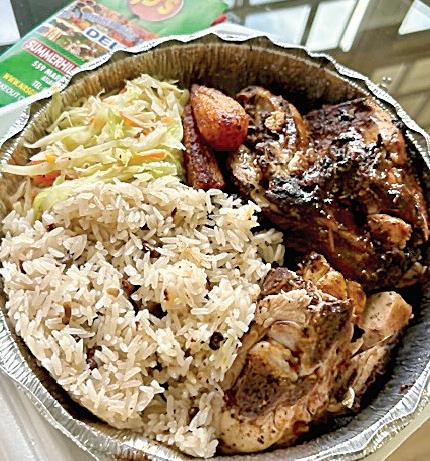
JD’s Variety Deli
559 Martin Street, Summerhill nrsgo.com/jdssummerhill
From the outside, JD’s Variety looks like many neighborhood convenience stores. Signs for playing the lottery, Coca-Cola and Community Coffee ads, and other notices are displayed on the windows and front door. Red bricks peek out from underneath the fading white-washed exterior of the humble building. But there’s more than meets the eye here, including a righteous takeout and delivery operation serving jerk chicken plates with piles of rice and peas, beef patties and coco bread, lemon pepper wings, and fried catfish dinners. I come here for the jerk chicken and jerk chicken egg rolls and the friendly conversation with owner Rosco Cummings.
Chicken slow-cooks on the grill out back starting in the morning. Smoke permeates the meat just enough to resemble the nostalgic taste of a backyard barbecue. There’s good char on the skin, too, which allows the warming spices and aromatics used in the seasoning to come through and the heat to build steadily on the palate. That hot spice mixture in the rub is essential for jerk. JD’s doesn’t shy away from bringing the heat.
Fluffy rice tossed with red peas is infused with coconut, giving it a mellow sweetness. Crispy egg rolls stuffed with shredded jerk chicken, onions, and hot peppers come served with a tangy dipping sauce.
Order food through JD’s website rather than a third-party delivery service – that way the shop can retain 100% of the sale. Services like GrubHub and UberEats get a pretty hefty commission from each order placed, sometimes as much as 30%.
With patio season in full swing, I wanted to share some of my favorite places to dine al fresco in and around Atlanta. Everyone has their favorite restaurant patio, but the ten patios I’m highlighting on this map always make me happy to dine outside.
From a lively beer garden in the heart of the Summerhill neighborhood to a vibrant restaurant patio for tapas and cocktails in downtown Alpharetta, check out these ten restaurants offering great spaces for outdoor dining.
The Chastain in Chastain Park
Sit on this lovely patio shaded by mature trees for lunch or dinner. Much of the patio overlooks the Michelin Green Star restaurant’s sprawling edible garden. The outdoor lounge has a fire pit and
is dog-friendly. Keep an eye out for Bogie, the friendly resident patio cat. thechastainatl.com
Larakin in Midtown
This coffee and wine bar, one block west of Piedmont Park, is perfect for lingering on pleasant days. Seating is all outdoors, too, and the patio is super dogfriendly. Grab a breakfast sandwich in the morning or freshly baked focaccia pizza later in the day. Weekends and evenings tend to be busy but no one seems to mind. larakinwineandcoffee.com
Continued on page 16

 The patio at The Chastain includes spots for a casual lunch or lounging around the fire pit and a tree-covered outdoor dining room. (Courtesy The Chastain)
The patio at The Chastain includes spots for a casual lunch or lounging around the fire pit and a tree-covered outdoor dining room. (Courtesy The Chastain)
During these uncertain times, HammerSmith is here for you and your family. We provide safe, essential services, architectural designs and home renovations. Start planning today for how to live better in a changed world. HammerSmith is here for you and your family. We provide exceptional architectural designs and home renovations. Start planning today for how to live better in an ever-changing world.

Staplehouse in Old Fourth Ward
There’s just something about eating hot wood-fired pizza, one of Chef Ryan Smith’s fresh salads, or sharing a charcuterie and cheese spread while sipping wine with friends on this sunny garden patio. Order at the counter first. Then find your way to the backyard for a seat in the garden or on the covered patio. Dogs and kids are always welcome here. staplehouse.com
Mediterranea in Grant Park
Dine on the quiet rooftop patio at this Mediterranean restaurant overlooking a tree-filled park below. Everything on the menu is completely gluten-free, and many dishes are also vegetarian and vegan. mediterraneaatl.com
Halfway Crooks Beer in Summerhill
This brewery features a covered rooftop patio and a lively beer garden serving food from a converted shipping container. Sometimes there’s live music on the weekends. Restrooms are available at the beer garden, which is also very dogfriendly and family-friendly. halfwaycrooks. beer


Downwind Restaurant in
Chamblee
I like to come to this restaurant institution for the burgers, gyros, and patio views overlooking the planes on the runway at PDK airport. It’s a fun way to spend your lunch hour. facebook.com/ downwindpdk
Osteria Mattone in Roswell
The patio at this Italian restaurant, from the owners of Table and Main, has long been an OTP favorite of mine. It features ample outdoor seating that winds around the front of the restaurant close to the tree line and a large, stone fire pit for warming up on chilly evenings. Wine is a must here. osteriamattone.com
Fogón and Lions in Alpharetta
Dine on stellar Latin American and Spanish fare and sip wine or a rum cocktail on this vibrant covered patio in the heart of downtown Alpharetta. Great people watching, too. There’s counter seating for folks who are just dropping by for drinks. fogonandlions.com
Gilly Brew Bar in Stone Mountain
Kimball Hoouse in Decatur
The front patio at this award-winning restaurant is covered now and a great place to dine on seasonal fare, slurp a dozen oysters, sip wine, and drink perfect cocktails on a warm evening. Pro tip for martini drinkers: order the Kimball House. kimball-house.com
When I’m in Stone Mountain, I never miss a chance to grab one of the creative coffee drinks and a bite to eat from Gilly. I typically sit upstairs on the wraparound porch. The coffee bar resides in the oldest house in Stone Mountain Village. gillybrewbar.com



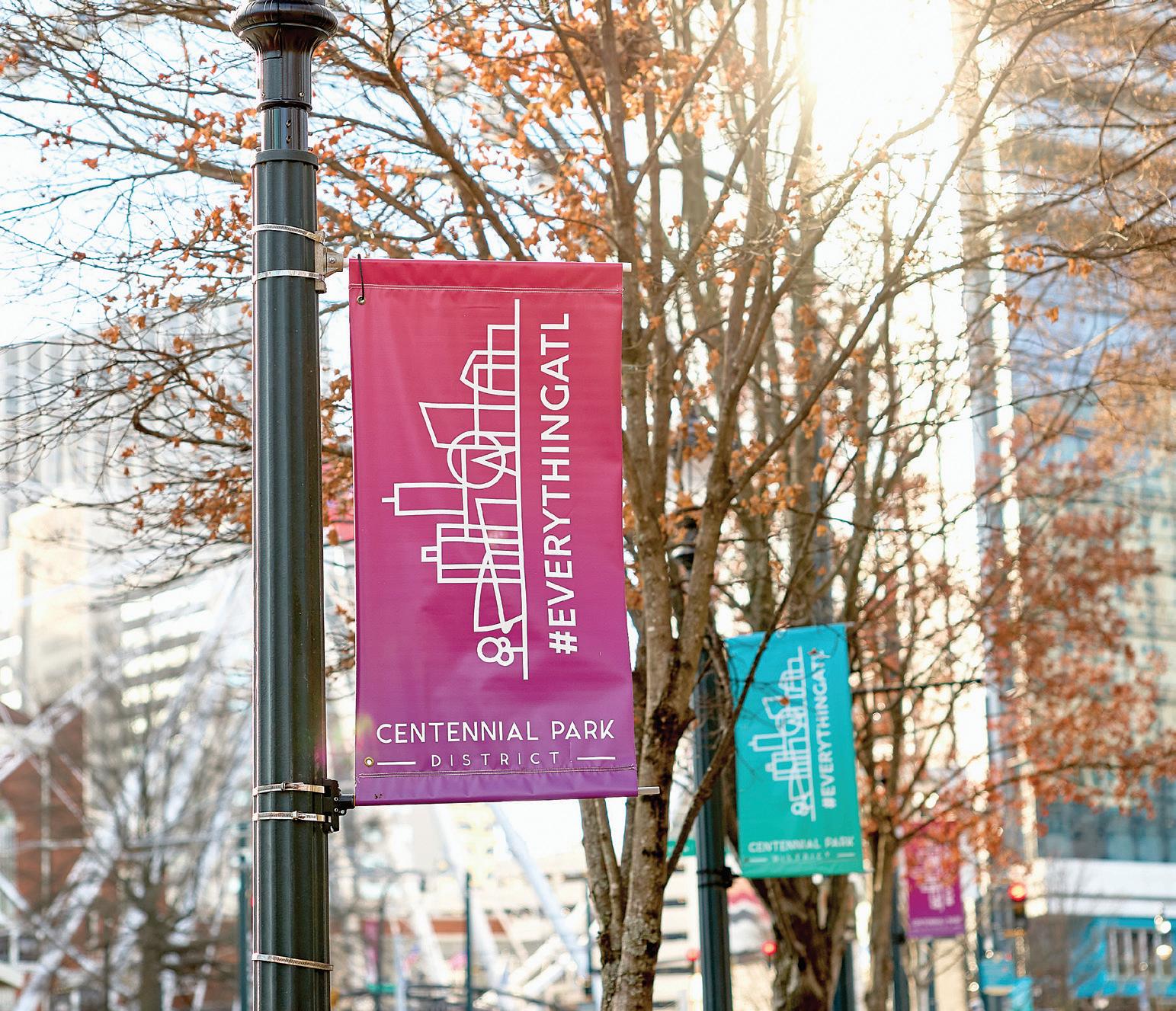
In the early 1990s, Atlanta Committee for the Olympic Games (ACOG) CEO Billy Payne looked out of his office in Downtown Atlanta and saw a bleak landscape between the city’s central business and hospitality core and future Olympic venues. ACOG raised $75 million in private funds to redevelop the area into an inviting park for visitors and residents. The result was one of the first urban infill parks in the country, Centennial Olympic Park. The area immediately attracted developers, restaurateurs and visionaries. Now, the District has grown into an iconic entertainment destination showcasing attractions, sporting events, conventions, restaurants, lounges and hotels.
With rooftops, terraces, patios and more, Centennial Park District serves up some incredible views at its restaurants and bars.

Try authentic German fare in a picturesque biergarten, with ample outdoor seating.
Catch a view of a different sort – Atlanta United away games – as fan clubs host watch parties when the MLS team is not playing at Mercedes-Benz Stadium.
Dos Bocas brings together authentic TexMex and Cajun flavors with a beautiful patio view of the city.
TOP DRAFT SPORTS LOUNGE
Step inside Omni Atlanta Hotel at Centennial Park to enjoy elevated bar fare on the terrace of Top Draft Sports Lounge, sporting a fantastic view of the park.

Travel to the top of the Glenn Hotel for expertly crafted cocktails and a showcase of the downtown city lights below.
RUTH’S
Settle into a patio seat overlooking Centennial Olympic Park’s emerald lawns and busy pathways.
RT60
The spacious outdoor terrace at this rooftop bar, located at the sleek and trendy REVERB by Hard Rock Atlanta Downtown, affords incredible views of Mercedes-Benz Stadium and the downtown skyline.
STATS BREWPUB
The hip rooftop seating area at this sports bar and brewpub offers great views of the District.
For a full list of District dining options, visit CentennialParkDistrict.com.




From sports games to concerts and more, these are just some of the events that make Centennial Park District unique.





February
This
DRAGON CON
August
Come
- September
AFLAC KICKOFF GAME
August 31
Catch Clemson vs. Georgia at MercedesBenz Stadium and pack in plenty of fan friendly opportunities.
ATLANTA FALCONS NFL SEASON
September - January
Get in the game at Mercedes-Benz Stadium with plenty of gridiron action.
ATLANTA HAWKS NBA SEASON
October - May
Don’t miss the excitement at State Farm Arena and come early to experience the arena and all its offerings.
Year-round events
Originally built as a church in 1911 and transformed into a music venue for the ‘96 Olympic Games, the Tabernacle is home to over 200 events a year and consistently ranked one of the top music venues in the country!
Daily programming
The city’s premier destination for interactive, educational, and hands-on exhibits. Climb to the center of the Earth, work on a farm, create a masterpiecediscover a world of possibility!
Scan this QR code to check out daily events on the Centennial Park District calendar!




























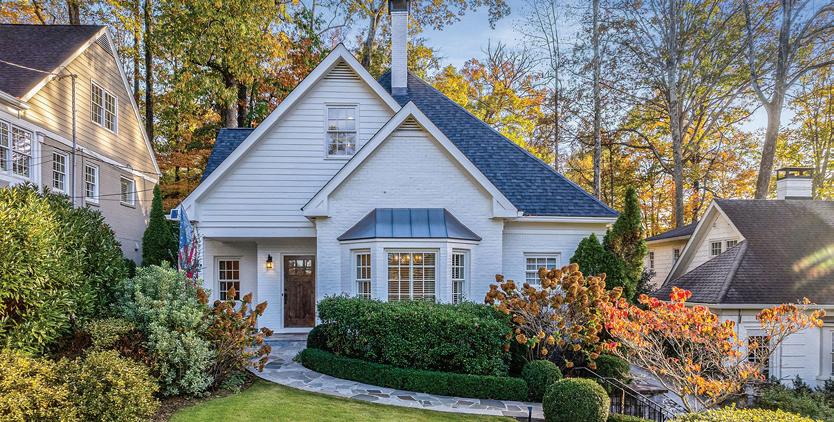












Chronicle your visit to Centennial Park District and hit these hot spots for the best shots.

Ocean Voyager, one of the largest single aquatic exhibits in the world, just so happens to house the largest fish in the world: whale sharks. Sit in front of the large picture window and capture not only the stunning whale sharks but Manta rays, goliath grouper and other swimming species.
Capture city lights at new heights on SkyView Atlanta Ferris wheel, across from Centennial Olympic Park. Buy a ticket, hop aboard and soar high above the city.
Behind the National Center for Civil and Human Rights facing Ivan Allen Jr. Boulevard stands a remarkable water feature depicting quotations by Nelson Mandela and Margaret Mead.
This 73,000-pound, gleaming statue of a falcon with outstretched wings making a touchdown looms above fans as they stream inside to catch a game.
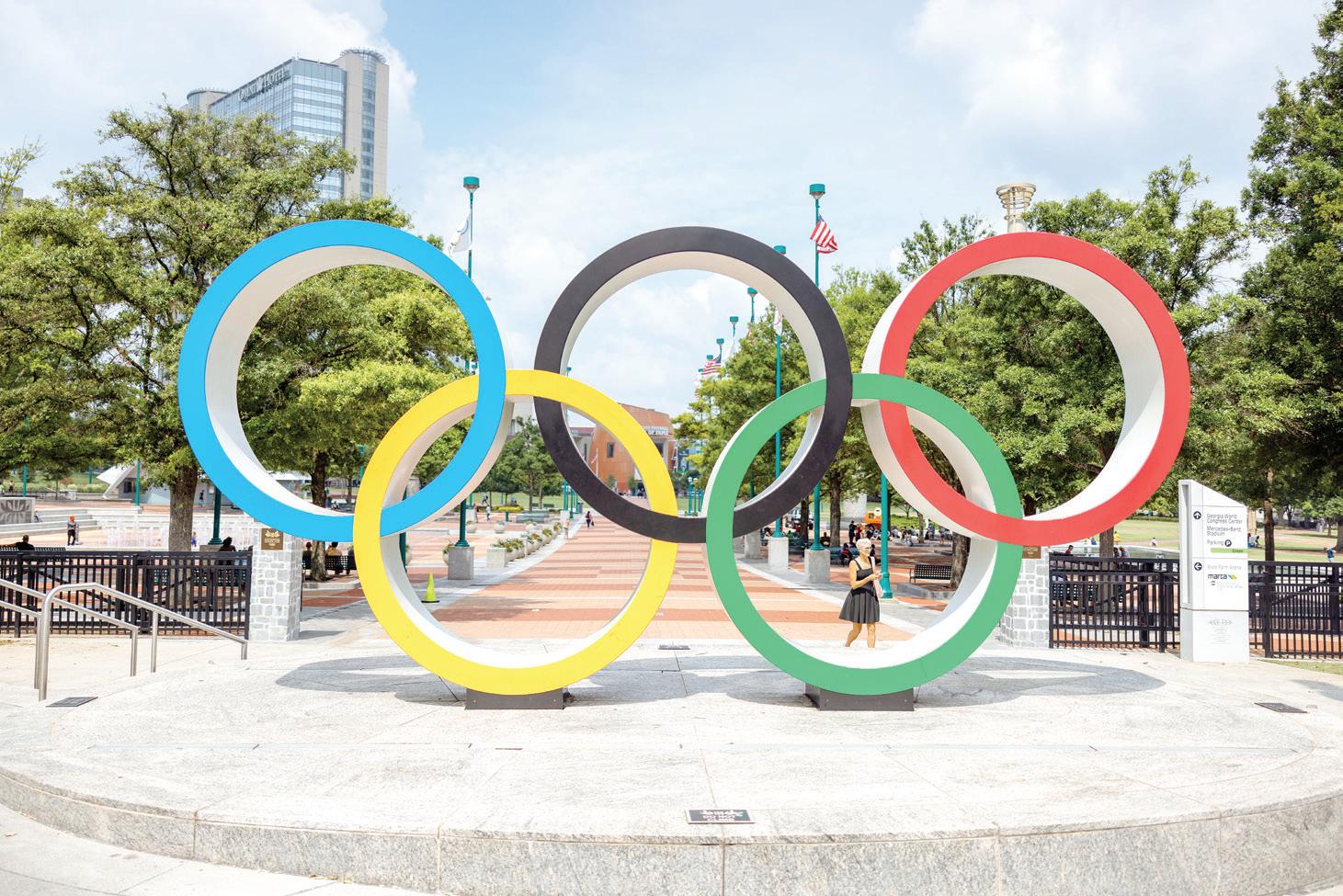
In Centennial Olympic Park, this 11-foot aluminum sculpture depicts the Olympic rings.
The Atlanta Convention & Visitors Bureau Visitor Information Center in Centennial Olympic Park proudly displays a colorful new interactive Atlanta mural by Lotus Eaters Club that features not one, but three Tiny Doors, part of a citywide art project called Tiny Doors Atlanta.
This truly eye-catching piece overlooks The Home Depot Backyard outside of the stadium. The mirrored, 25-foot round sculpture of a soccer ball has 186 reflecting surfaces that catch the sun at different points during the day.
Stop by for insanely delicious milkshakes poured into pint jars and piled high with toppings that run the gamut from

white chocolate mermaid tails to glazed donuts, pretzel pops or a slice of New York cheesecake. Don’t forget to take pictures before eating.
Travel to this hip, happening hotel to snap a picture of the colorful city skyline mural painted on the side. A brilliant sun rises from the skyline, and the word Atlanta artfully displayed at the bottom makes this a perfect Insta-worthy shot.







ATLANTA
Downtown Atlanta has been filled with light, art, and cultural programming through Arts & Entertainment Atlanta. New outdoor media, local art, accent lighting and digital and static signage converge to activate buildings and
previously blank walls. To learn more and view a map of the A&E Atlanta signs, visit aeatlanta.com.
Situated between World of Coca-Cola, Georgia Aquarium and National Center for Civil and Human Rights, the expansive

green lawn and beautiful downtown skyline make for splendid shots.
At the Chick-fil-A College Football Hall of Fame, personalize your entire experience
by registering your All-Access Pass. Then identify your favorite team from the over 775 schools represented and watch as your team’s helmet lights up on the enormous three-story Helmet Wall.









The
Impact of the Civil Rights Act on its 60th Anniversary

Send us photos of you and your pets

When I presented my writing students at the Atlanta campus of the Savannah College of Art and Design with the idea of an issue themed around the 60th anniversary of the Civil Rights Act anniversary for our collaboration with Rough Draft, they were not thrilled, to say the least.
And I get it. For many, the term “civil rights” has been reduced to a myopic, over-simplified story of Dr. Martin Luther King Jr., and that story often counters the injustices they face on many fronts in their daily lives despite the progress made in the wake of the Civil Rights Act.
Signed into law by President Lyndon B. Johnson on July 3, 1964, the act –introduced into legislation after years of activism and protest from organizations such as the Southern Christian Leadership Conference, the Atlanta Student Movement, and the Student Nonviolent Coordinating Committee – outlawed discrimination based on “race, color, religion, or national origin.”
As we all know, forms of
discrimination continue to this day and have seen a resurgence in the last few years.
In our many discussions thinking about civil rights and Atlanta, students articulated the ways in which they’re tired of the old narratives surrounding civil rights, perhaps because they’ve never been fully realized, perhaps because some of these narratives neglect so much about Atlanta life today.
So, students covered the multitudes of our fair city—the ways the Civil Rights Act of 1964 led to Atlanta’s welltouted cultural diversity, as reflected in our residents who come from around the world and in our proud queer communities. These articles look at how Atlanta has given space for entrepreneurs and activism, as well as the inequities that still exist.
But reporting the articles in this special issue of Rough Draft proved to be step one for these emergent writers— in telling these stories, they’re doing the work to help write Atlanta’s new narratives.
For our July issues we will be feature photos of our readers with their beloved furry and feathered friends in the annual Pets & Their People issue, sponsored by Scenthound.
Grab your pup, kitty, rabbit, guinea pig, parrot, or other critters and pucker up for the camera.
Send your high-resolution images (1MB or higher) by June 14 to pets@roughdraftatlanta.com.
Be sure to include your name and your pet’s name.
In Partnership with

The stories presented here are just a sampling of a larger body of work created by the writing students during this collaboration. Scan the QR code or visit RoughDraftAtlanta.com and you’ll find additional reporting and features related to the theme of the Civil Rights Act anniversary. The stories include features on policing in the city, finding community at local farmers’ markets, the Atlanta Opera, visiting the historic restaurants that fed the Civil Rights Movement, and much more.

Austin, Texas native Melissa Richardson, the artist who create the cover image called “Be the Good,” is an illustrator who finds inspiration in the power of endless possibility. Always encouraging others to dream big while doing so herself, this piece was created after a realization that as different and unique as all of our paths may be, a sense of hope occurs when people come together. Through bold, powerfully positive color palettes that she typically infuses in most of her work, Mel captures that we have the power to see the good, the power to be the good, and the power of curiosity to channel the good in all we do to make our world a stronger, more united place. Find out more at Melmakes.com or on Instagram @Melmadeart.
 By Stephanie Dejak
By Stephanie Dejak
Global Black Pride will make its American debut in Atlanta on Aug. 27 – Sept. 2. The week-long festival aims to highlight and celebrate the strides made by the Black LGBTQ+ community in the fight for equal rights over the past 60 years.
Global Black Pride coincides with Atlanta’s annual observance of Black Pride, followed by the Atlanta Pride festivities Oct. 12-13.
“We are honored and excited to bring Global Black Pride to the United States for the first time, choosing Atlanta as our host city,” said Michael Ighodaro, the organization’s co-founder and president, in a press release. “Known for its deep roots in civil rights history and a vibrant sense of community, Atlanta is the ideal location to celebrate our diversity, resilience, and the ongoing fight for equality and justice.”
What later became the Global Black Pride movement was originally a 12-hour virtual conference held in the summer of 2020 called “The First Global Black Gay Pride Is a Riot,” founded by Global Black Gay Men Connect (GBGMC). The panelists for the event consisted of activists and allies from Africa, the Caribbean, South America, Europe, and the United States. GBGMC partnered with gay dating app Grindr for this self-proclaimed “joyful riot” in 2020, which was just a month after the police brutality protests surrounding the murder of George Floyd in Minneapolis.
“Pride in 2020 came not only amid a global pandemic but also as the United
States was seeing nationwide protests against racism and police brutality,” wrote Alex Black, creative director at Grindr.
“Our attention quickly shifted away from the typical hallmarks of Pride — parades, parties, and protests — to figuring out how we could help people celebrate safely from home while also supporting queer artists, activists, and entertainers whose livelihoods were being impacted by the pandemic.” As a result, “The First [Virtual] Global Black Gay Pride Is a Riot” was born.
If you’re caught up on queer history, there’s no doubt that the very first Global Black Gay Pride was a riot. It happened 55 years ago at a gay bar in New York City. In fact, Pride month wouldn’t be celebrated nationwide in June if it weren’t for the iconic Marsha P. Johnson, a Black drag queen who led a series of protests after the police raided the Stonewall Inn on June 28, 1969.
So, that’s the reason — if you’ve ever attended a queer pride parade here in the United States — why the festivities are usually held in June. Atlanta Pride, which coincides with National Coming Out Day on Oct. 11, was originally held in June, too, but was pushed to the fall after Piedmont Park was closed in 2008 due to storm damage. Organizers decided to keep it in October.
However, there are even some events in Atlanta during National Pride Month, such as the annual Atlanta Pride Run and 5K on June 2. Be sure to check out AtlantaPride.org to see all the events happening in June and beyond.






Fifty years ago, Atlanta Braves right fielder and designated hitter Hank Aaron beat the home run record of legendary slugger Babe Ruth to cement his legacy in stone. Aaron hit his 715th homer on April 8, 1974, at the nowdemolishing Atlanta-Fulton County Stadium.
Aaron went on to hit 755 home runs from 1954-76. His monumental record has only been beaten by Barry Bonds, who had to use performance-enhancing drugs to do so. To commemorate the 50th anniversary of breaking the record, the U.S. postal service created a stamp, the Braves organization released a video,
and the Baseball Hall of Fame in Cooperstown is set to unveil a bronze statue of Hank Aaron on the first floor of its historical museum this summer.
These honors will add to the already large number of dedications Aaron has received, ranging from street names, busts, statues, and even an entire stadium in Mobile, Alabama where Aaron was born.
Aaron, who died in 2021 at 86, left an unforgettable mark on the sport as one of the most prolific hitters in baseball history. But a ball player's career is only a short part of their life. As Aaron’s career

began to wind down, he extended his influence so it wasn't strictly constrained to his on-field prowess.
An activist off the field, he used his platform to advocate for equality and social justice. In 1984, eight years after retirement and two after being inducted into the Hall of Fame, Hank Aaron met the reporter who would get to know him better than anyone else – his eventual biographer, Terence Moore.

“The Real Hank Aaron: An Intimate Look at the Life and Legacy of the Home Run King” looks at every aspect of Aaron’s life. According to Moore, at the time the two met Aaron was the only African American executive in Major League Baseball.
“[I found] we were very similar in the sense that we both understood this concept of mind games as racism because one of the things that got lost, that I point out in the [biography], is people always think his racial issues took place when he was chasing Babe Ruth’s record, and that’s it,” Moore said. “But what I detailed in my book is that he was also facing racism when he became an executive with the Braves.”
It was during this period that Aaron became very outspoken when it came to talking about the lack of Black people within and surrounding baseball. According to Moore, in 1982 about 18% of major league players were African American. The current number is roughly 6%.
Aaron’s statements went beyond just players. He wanted to see change on the management side of things as well.


“He was also very outspoken about Civil Rights, and what people refuse to admit then and even now,” Moore said. “White folks couldn’t stand Hank Aaron because of that. He was getting hate mail, I know [because] he would show me… he was getting phone calls from people getting upset with him telling him, ‘You need to stay in your place!’”
Those people, Moore said, wanted a “squeaky clean” version of Hank Aaron who did his work and would be there to be the famous token Black player.
“They don't want to hear the Hank Aaron talking about, we need more Blacks in the front office, we need more Black players, we need more Black senators,” Moore said. “Hank was all of that.”
In his 1982 Hall of Fame speech, Aaron left the world with one of his most impactful statements: “A man's ability is only limited by his lack of opportunity."
His quiet strength, well-placed words, and unwavering commitment to excellence made Aaron a role model for aspiring athletes and activists. At the end of his career, Aaron took steps to make sure his influence wouldn’t be limited to just the baseball field. After an illuminating conversation with then Milwaukee Brewers President Bud Selig, he created the Chasing the Dream Foundation, which has provided countless scholarships to deserving Boys & Girls Clubs students.
“I don’t want anything,” Aaron said in a 2020 Forces article. “I just want something that says that ten years from now, Henry Aaron has put his fingerprint on somebody to help them get through college and make them better than what they were before. That's where my Chasing the Dream Foundation came from.”
Before his death, Aaron was still striving to create unity. He dreamed that the generations coming forward would choose to build relationships that would move society forward.
“I just wish that these kids today would find out that it's not just money alone,” he said in the Forbes interview. “It's not just what you can get out of someone, but [also] learn how to be able to get along with other people, as well as to get along with yourself.”
It’s 7:30 a.m., and I have two orders from Smoothie King. The orders aren’t ready – even though the app stated they were.
DoorDash is a timed gig. Every moment counts as part of your delivery rate. I messaged the customers to inform them of their order status. They cooperated with me nicely, and I continued to wait for the only employee available to complete all incoming orders, including the walk-ins. Five minutes turned into 10 minutes, then 30 minutes. At this point, I was irritated.
Finally, I gathered both orders and drove 20 minutes north on I-75. The first order was simple. The instructions said: “Leave the order at my doorstep.” Placing the order at the door, I took a picture as instructed and headed to my next drop-off. I signed up for the guaranteed $17-an-hour surge pay rate. At the second location, the customer requested that I hand her the order. As I arrived at the customer’s residence, it was clear I needed a gate code to enter. It took 10 minutes to get in touch with the customer. She told me she would tip me for the inconvenience caused – and never did.
My payout for both orders was $10.
I had four more hours to go on my shift. Luckily, I was still able to meet my goal of $50. The metro area houses over 6 million residents, creating a demand for Instacart, DoorDash, Lyft, and Uber drivers. The rise of gig workers is becoming substantially competitive and in some cases necessary for residents to make extra cash to maintain their lifestyles.
Gig workers have soaked up the market for so long that some of them have crashed and burned. Some might question whether being a gig worker is worth the hassle or the dazzle of extra cash. In my experience, the pay for an eight-hour shift is around $88 to $128 a day for Instacart shoppers. This value could go up to $300 depending on which areas have high demand. For DoorDashers, the hourly pay in Atlanta is roughly $17 to $19 an hour.
The number of gig workers is growing, and their impact is being felt throughout the city of Atlanta. Two local Instacart shoppers, Kassandra Evans and Alexyus Rice, shared what the gig life is like.
At 8 a.m. Evans drops her son off at school and begins her shift. Evans works 15 hours a week making an extra $150200 a week on top of her 40-hour shift at The Fresh Market. Evans has been an active Instacart shopper for four years.
"I had an order that consisted of 240 items,” Evans said. “The customer lived on the third floor of her mid-rise. I had to make six trips up three flights of stairs back and forth. This included three cases of 24 packs of water. I only made $8 on the batch with no tip."
Evans often feels anxious to accept certain orders after this experience. However, she still manages to meet her weekly goal and continues to make Instacart her side hustle.
Rice has worked for Instacart for three years. Her weekly average payout is roughly $200. Rice is a full-time accountant for a medical company in Sandy Springs, but averages 15 hours of Instacart orders on the weekends.
"I don't do this full-time,” Rice said. “I remember one time I was shopping for a customer. We had a great back-and-forth dialogue about replacement items, refunds, and the overall selection process. Upon completing the shopping batch, I drove 15 to 20 minutes in traffic to drop off the customer's groceries. Upon arrival, they never answered their phone to open the gate.”
Rice eventually called Instacart's help center and they told her that they would pay her to return the items to the


store. When Rice returned to the store, however, they didn’t accept the returned items. She was stuck with $300 worth of groceries that she didn’t even want. Gig work can ease your financial burden, but it can be difficult too. Pick your financial poison.




Discover patterns in the world around you through fun and interactive experiences.
• Navigate a 1,700 squarefoot mirror maze
• Find patterns using projections and a two-way mirror
• Expose the mathematical patterns in nature
• Compose your own music using symmetry

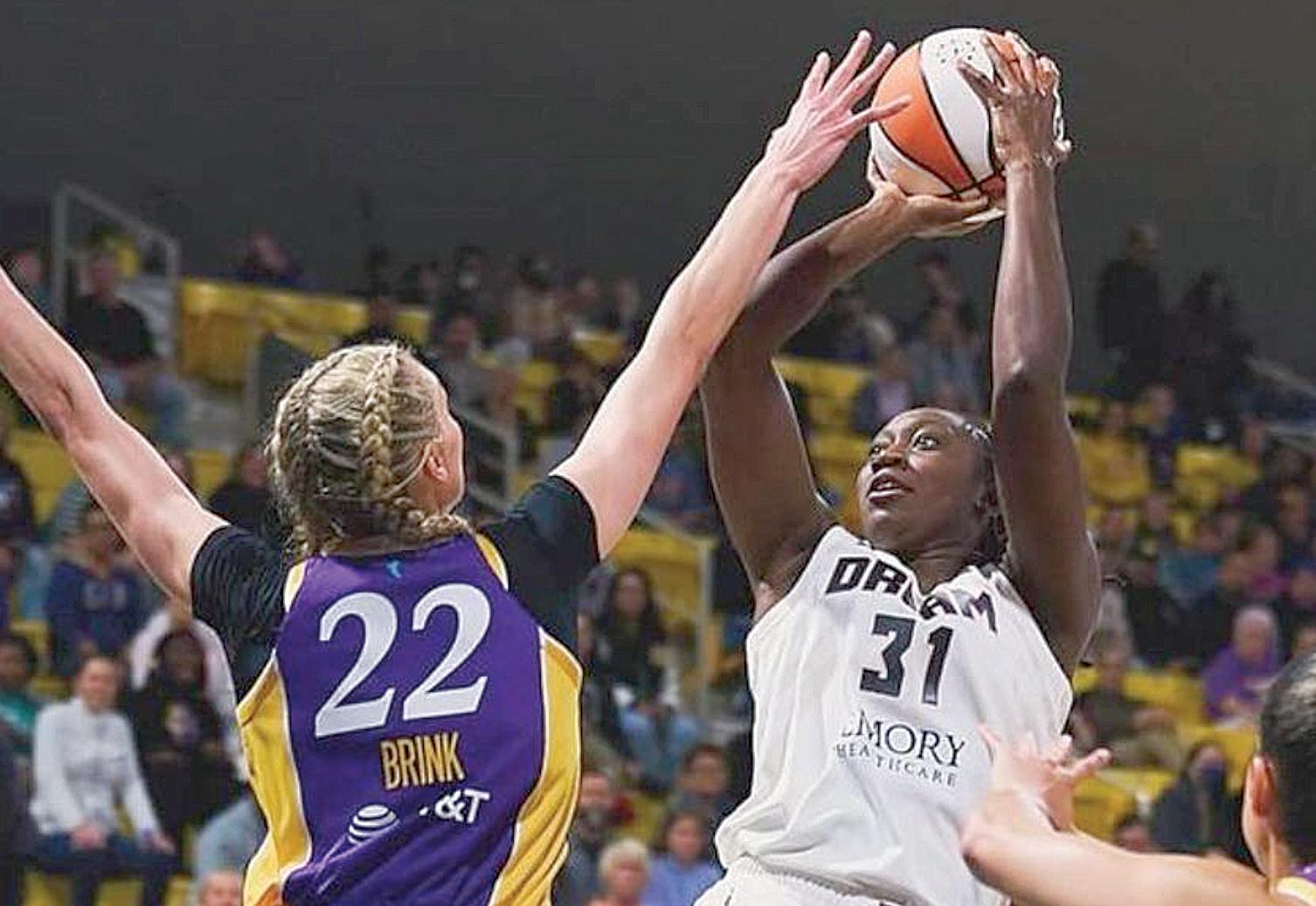 By Galyn Chatman
By Galyn Chatman
In 2024, the most watched college sporting event – excluding football – across all major networks was the March Madness women’s championship basketball game between the Iowa State Hawkeyes and the University of South Carolina Gamecocks. It shattered records for industry networks like ESPN, marking a huge feat for women athletes who only 53 years ago were not permitted to play full-court basketball games.
Sixty years ago, when the Civil Rights Act passed, the idea of 18.3 million individuals watching women play basketball might have sounded like an impossibility. But the 1964 signing of the Act would
pave the way for Title IX, prohibiting discrimination based on sex in education programs and activities. It was a game changer for girls’ and women’s participation in sports.
In 2023, the National Federation of State High Schools Association reported around 6 million high school students participated in sports during the 2022-23 calendar year. Of those engagement rates, Georgia ranked number 48 out of the 50 states for girls’ participation.
Morgan Shaw Parker, president and chief operating officer of the Atlanta Dream WNBA team, said she was disappointed by the low ranking.
“It’s alarming to me. That’s why we need to lean into this community as much
The Alpharetta Farmers Market returned in the spring with a slew of new and familiar vendors, including Akayati Crafts Centre’s stall filled with a variety of colorful bags and baskets.
While other stalls advertise their farmto-table products, the Akayati stand is different. Their products travel thousands of miles to be sold at the family-run stall each Saturday, and for good reason. They are the only vendors at the market that sells authentic, handmade Ghanaian woven baskets.
The Akayati Crafts Centre is a Sugar Hill-based small business with roots in the historical Cape Coast of Ghana, making it the only stall representing an international small business.
The stall offers a variety of handdyed and woven baskets that have been imported from Ghana. Those not imported have been made using imported, traditional materials.
“I ship straw from my village in Ghana and I hand weave the baskets myself at my home,” said Baba Akayati, co-owner of Akayati Crafts.
Their full selection of Bolga baskets are also available in Akayati’s online storefront (akayaticraft.com) and vary in shape, size, and color. Some of their basket selections range from traditional round and square shapes to more unique shapes like pet beds and shoulder bags.
Bolga baskets are internationally known, not only for their unique and intricate patterns, but their durability. Their longevity can be attributed to the fact that they are handcrafted by native weavers from Bolgatanga, Africa.
“My region and village are known for our basket weaving patterns, passed down for generations,” Akayati explained.
This weaving practice, from which
the baskets get their name, has been built around a long-standing and well-respected culture of craftsmanship. Bolgatanga uses handicrafts to supplement their agriculture-based economy.
“I learned how to basketweave as a child,” Sharece Jackson, co-owner of Akayati Crafts said. “Basket weaving is the main source of income for my village.”
The art of grass weaving is passed down to each generation from elder to child, primarily through family matriarchs. Village women utilize a sustainable practice of “kinkahe,” or elephant grass collection, which leaves the root of the grass intact. The grass returns from the roots left in the undisturbed soil to be collected again in the future, making the practice fully sustainable. Jackson spoke of her childhood experience learning the art of “tehei.”
“As a child, we learn to chop and naturally dye the straw. When you get a little older, you are taught weaving patterns specific to our village.”
Due to the often unpredictable climate of Bolgatanga, handcrafting ensures that a valuable export can still be available
during times of low harvest. These crafts range from leatherwork to pottery and are primarily done by native women.
Akayati Crafts maintains the sentiment of supplemental economic support by donating proceeds from their basket sales to local schools in the Cape Coast, where brothers Baba and Joseph Akayati started the business in 2002.
“The money sent home helps with generational change by paying school fees for the next generation,” Jackson added.
The funds generated through sales at
venues like the Alpharetta Farmers Market are felt in the Cape Coast as donations through Akayati Crafts Centre were able to supply 80 school desks to Afrangua and Mpeseduaze Basic School in January.
The Akayats went on to explain how supporting their business impacts their village in Ghana.
“By supporting our business, customers are encouraging our family in Bolgatanga, Ghana to continue to preserve our cultural heritage of basket weaving that is hundreds of years old,” Jackson explained.

as we can,” Shaw Parker said, noting that Georgia has approximately 77,000 girls playing sports, but many will fall out of participation by age 13 – a statistic similar to that of STEM. “It’s why we’ve partnered with Microsoft to form clinics that empower girls and women in the Atlanta area.”
The program zeros in on middle schoolers where, as of June 2024, 18,352 of the 43,407 girls registered in the Atlanta Public Schools system are Black and living in underserved communities. This fact resonates with the Atlanta Dream, whose WNBA league of athletes are 85% Black, according to Shaw Parker.
Visibility and access are high on the priority list for Shaw Parker. She attributes
personal and professional achievement to participation in team sports.
The idea is not far-fetched. A recent study conducted by Ernst & Young found that 94% of women executives participated in team sports during their youth, either in high school or college.
“Sports impact women so differently, especially where business is concerned,” Shaw Parker noted. “Failure is mandatory when it comes to progress in business. You have to have confidence to be able to fail forward. What did you learn from the failure, and how will you make it better next time? Sports test you in these areas.”
In February, Laila Brock, the Atlanta Dream’s senior vice president of strategic partnerships and community impact,
participated in a mentoring event sponsored by the local nonprofit Women in Sports and Events (WISE). She is among the many women affiliated with the WNBA team who don’t think of their role on the Dream as simply work. For some, it’s a way of life.
Head coach Tanisha Wright and guards Rhyne Howard and Haley Jones come to mind as Shaw Parker emphasizes the unsung heroism within the Dream organization. Their performances and leadership are among hundreds of women whose work is deserving of recognition that often goes unseen or garners little or no attention at all because of the stigma that persists in the sports world.
“You have to see this,” Shaw Parker said. “You have to Google the name Switzer,
women, uterus, sports.”
She is referring to Katherine Switzer, who made history in 1967 after becoming the first woman to run the Boston Marathon. In her memoir, she describes a basketball coach at her high school telling her that women would never play men’sstyle basketball because too many jump balls could “displace the uterus.”
“We aren’t far away from those days, but we are finally being recognized for the work we’ve done in the dark for decades,” Shaw Parker noted. “Sports has been a catalyst for change. If we help women continue to understand and recognize what they bring to the table, as a community we can take this moment and turn it into momentum for the future.”


 By Cashmere Chillious
By Cashmere Chillious
When I first came to Atlanta to attend the Savannah College of Art and Design (SCAD), I was always looking for places to hang out. I went online to find places I could shop that weren’t just Forever 21 or H&M in Atlantic Station, and Little Five Points was one of the first places I found
in a Reddit forum for “Hippie places in ATL.”
When visiting Little Five Points, you see a lot of styles and personalities that you wouldn’t usually see in other places in urban Atlanta. Groups dressed in emo punk with 1970s-style mohawks, bohemianstyled women with copper-wrapped crystal necklaces, and musicians playing in the center of the street. As I walked around, tote bag on my shoulder, I saw a few people who looked like me.
As I searched, I realized that Little Five Points is a place where you have to dig beneath the surface. Just across the street from The Vortex Bar & Grill is a store called Bear and Honey Candle Co. (bearandhoneycandle.com), a Black-owned and family-operated candle shop with various types of candles made of beeswax, soy wax and coconut wax.
Bear and Honey has been in Little Five for the past four years, starting during the beginning of the COVID-19 pandemic. I spoke to people around the area and found
Kayle Lewis, who was happy to share her feelings about the shop.
“My family is very natural and whenever I go into Bear and Honey, I feel like I’m walking into my aunt's house rather than a business, which I love,” Lewis said.
Lewis said she loves places like Little Five because they make her feel at home.
“It makes me feel normal for being a Black woman and having alternative styles and not being stared at for it,” Lewis said. “Everyone has their own style and lives going on, so no one is in your business.”
Lewis said another one of her favorite shops was Vintage Mama (vintagemamaatl.com), located in the Bazaar – a corner in Little Five Points that houses multiple boutiques and services within the area. Vintage Mama specializes in rare and unique vintage and throwback styles for women and men.
“I’m in love with vintage items and the owner is so sweet,” Lewis said. “I feel like I’m given the space to look and walk around without someone breathing over my shoulder.”
The owner of Vintage Mama, Pecco Costen, has been a part of the antique and vintage community for over 30 years and in Little Five Points since 2018.
“I started back in 2018,” Costen said during an interview on Vintage Mama’s TikTok. “It’ll be six years here in Little Five Points. I do a lot of shopping when I go out of town, when I’m traveling. I just try to find nice, quality pieces.”
After visiting Vintage Mama, I started looking for other places in the Bazaar that had the same eclectic energy. One patron,
Josiah Kinslow, told me to go to Pop Basel Gallery (popbasel.com).
“Pop Basel is a cool store,” he said. “I’ve had a rug made by the owner there and it’s very well-made.”
Kinslow said he loves Little Five Points in part because of the sense of community between stores.
“There's no sense of competition or animosity between stores,” he said. “Especially that guy's store [Pop Basel Gallery], because of how inclusive he is.”
Pop Basel Gallery is owned by William Floyd, and has been located in the Bazaar for the last two years. Pop Basel has tufted rugs and upcycled clothing made by Floyd, as well as crochet pieces created by an artist out of Detroit.
“A main reason why I decided to create a space is to open up the community, but also somewhat of a haven for creatives to kind of come to hang out and get information, network, and just know that they have a place,” Floyd said.
Floyd said he considers the business community in Little Five Points to be a diverse one.
“When talking about Black versus white-owned businesses and Little Five Points, as far as just the overall community, I think it’s fairly diverse,” he said. “You know, when it comes to the mix of people and even the surrounding area, it’s very diverse as well. I think depending on the days to come, you're gonna see different crowds of people.”
So, if you’re looking for somewhere to shop locally in Atlanta, Little Five Points is the place to be.
Lovers of the arts and activism can find solace in glo, an Atlanta-based nonprofit seeking to educate and inspire through choreography.
According to its website, glo’s mission is “to raise consciousness, repair communities, create change, and bring forth social impact through ongoing action.”
According to the organization’s founder, lauri stallings, “Atlanta is the perfect place for that.”
The movement of the body has always been a sign of freedom. Take Josephine Baker, a dancer turned World War II spy, who used the horrific tropes lobbied against Black people to make fun of the absurdities surrounding minstrelsy. Or Kennedy George and Ava Holloway, two teenage ballet dancers from Richmond, Virginia who used their platforms and dance moves to advocate for the Black Lives Matter movement.
Glo has continued this tradition, and stallings takes pride in the fact that glo is a female-led organization active in the South.
“The work I’m involved in is about trying to bring intention and love and beauty back to the source, to its origin. I don’t think this work could happen anywhere else in the world,” stallings said. “Being an activist isn’t a choice. We have more work to do, and so the movement continues.”
She said that her father’s history as an activist is what pushes her to continue trying to tell stories through physical means. His activism pushes her to keep faith and continue.
“I’m thinking about those dimensions, and how I’m carrying him and he’s carrying me,” stallings said.
When she founded glo in 2009, stallings chose to refer to her team as “moving artists” instead of dancers after weeks of deliberation. She credits these moving artists with the ongoing success of glo’s mission.
“When I thought of that term, moving artists, I remember being really excited,” she said. “I think they’d be angry if I called them dancers. They’re so much more than that.”
Since its founding, glo has featured at the High Museum of Art, Hambidge

Arts Center, Atlanta Symphony Hall, and more.
Up next for glo is “Making Kin” tthat seeks to invoke a cultural understanding of history through live performance. Music from Lonnie Holley’s 2013 album “Keeping a Record Of It” will be used throughout this performance.. Holley’s music has strong notes of reggaeton and R&B, a music genre primarily used by Black people in the Deep South to express the pain and agitation they have
experienced under oppression. “Making Kin” premieres June 18 and continues through June 22 at the High Museum of Art.
With more pieces to come, stallings is consistently working with teams of people to bring the vision of both artists and activists to life. To find out more about all the upcoming events and workshops, visit gloplatform.org.
 By Simone Calcote
By Simone Calcote
With the recent banning of hundreds of books in Florida and Illinois passing groundbreaking legislation to outlaw such bans, where does Georgia stand in this political and cultural controversy?
Since 2022, Florida has made the process of banning and challenging books easier, this caused backlash that the state is now trying to correct due to abuse of the process. The ban on book bans in Illinois is the first of its kind, but its broad rules have confused advocates. The state of Georgia has seen fewer book bans and challenges, but there have been no solutions to the issue. Daniel Cruz, a Free Expression and Education program coordinator at advocacy group PEN America, said that not all book bans are reported, so Georgia’s real status is unknown.
Daniel believes children need as much access to books as possible “Because you have rights guaranteed by the First Amendment. So not every book is for every person and that’s okay, but if you want to read a book, you should be able to read it.”
One notable book-banning case in Cobb County led to the firing of teacher Katie Rinderle, who read “My Shadow is Purple," a picture book about gender fluidity, to her class.
In 2022, Georgia passed Senate Bill 226 that allows parents of a particular school to be the only voice suggesting a book ban in their school– making it harder for national organizations to challenge bans. This bill puts the power into the hands of the parents, but Tiffany Armstead-Flowers, an assistant teacher at
By Ahava RonnAtlanta readers are getting more from their local independent bookstores than just a good read. Customers are finding that a bookstore can be an inclusive “third space” –a distinct social space apart from home and work.
Justin Colussy-Estes, store manager since 2016 at Decatur children’s bookstore Little Shop of Stories, believes that independent bookstores are most successful when they “identify what the community wants and meets those needs.” This store creates an inclusive space for all ages with themed book clubs for kids, teens, and grownups.
“I left the store the way I always leave it, a little bit happier, with a little bit more faith in the community” says Emily, in her blog post about Little Shop of Stories. Emily says that she always recommends it to friends and that all the books “seem personally curated.”
starting in 2023 has been community art making. The second Sunday of every month Barry Lee, a non-binary, disabled artist and writer, and Noah Grigni a disabled, transgender, artist host this free “creative kickback.”
“All you have to do is show up,” Rollins said, noting that attendees have great conversations at these events, “sometimes personal, sometimes political.”
Open space for diverse content is also a central mission for Atlanta Vintage Books (AVB) in Brookhaven.
Owned by Jan Bolgla and Bob Roarty, the sprawling shop is home to more than 80,000 used, new, collectible, and vintage books. The duo have been accumulating literature and ephemera as well as building connections since they bought the store in 2007.
Georgia State University who is working on a project to eliminate book deserts, argues that the decision should be in the hands of librarians and teachers who have the training to know what should and shouldn’t be banned.
According to Armstead-Flowers, “I think when you start putting decisions in the hands of people who don’t have the academic training to do it, it’s going to be a problem. It’s like having a nurse decide whether someone needs surgery or not, instead of a surgeon.”
Right-wing groups like Moms for Liberty have been working around the parameters of Bill 226 by working directly with parents to ban books. Often, these bans target books about LGBTQ+ people and people of color. Parents can submit lists of books they want banned, which requires the school system to remove and review the titles before a ban is approved or denied.
A poll by the American Library Association found that 67 percent of voters oppose removing books from school libraries. However, according to Armstead-Flowers, if people aren’t participating in voting, and if they aren’t looking out for these bans, then “somebody could come along and decide they don’t want children to read any books.”
Roberta Gardner, a reading and literacy education professor at Kennesaw State University, said one way to work towards solving this issue is to let students get more involved and teach them how to become more active in this discussion.
Gardner said students getting involved can often help push forward changes in attitude and policy towards book bans.
The “event-driven” store started hosting a banned book club when a frequent customer brought the issue to their attention. The club discusses the book, why it was banned and they “have a good time fighting the good fight against ignorance and fear,” according to their website.
Little Shop of Stories was presented with the Pannell Award from the Women’s National Book Association in both 2010 and 2020 which “recognizes bookstores that enhance their communities by bringing exceptional creativity to foster a love of reading.”
“This was something I wasn’t expecting when I bought the store, but it’s almost like a community,” Bolgla said. Since the inventory is mostly used books, the store fosters a diversified community with its open-door policy and wide selection of specialty literature.
“The most important thing is our customer having a good friendly place to

Another local independent bookstore nominated for this award in 2014 is Charis Books and More in Decatur.
Charis identifies as “southern, queer, anti-racist” and as one of the 25 feminist bookstores still active in the United States. Charis hosts more than 270 events per year. They “believe in the power of specific identity-based movement spaces at specific times for specific causes” as stated in a note from 2020.
Charis has been “celebrating radical and independent voices” for 50 years, providing an accessible space for radical and independent groups to organize. “It’s about having a space where you can come together,” said Dartricia Rollins, an activist, bookseller, and assistant director at Charis Circle the non-profit programming unit of Charis.
One of the ongoing community events
come,” Bolgla said. The store has two floors of books with categories including radical literature, African American studies, history, LGBT, philosophy, religion, and more. Both floors have seats open to any guest who comes in. AVB is also home to Bolgla and Roarty’s cats, which roam free and mingle with guests.
Bolgla and Roarty get calls and emails daily from people who want to sell them books or have specific requests. They’ve also become a go-to shop for the film industry.
“We’ll get a call for 30 feet of children’s books,” Bolgla said.
Books that aren’t suitable or not in demand at the store are donated to local Friends of the Library groups, as well as prisons and community centers. “We make sure they get somewhere where they’re needed,” Bolgla said.
 By Kathy Dean
By Kathy Dean
The Intown real estate market has remained active, despite higher interest rates. Local real estate professionals report that businesses, investors and new residents continue to be drawn to Intown, resulting in high prices and low inventory, especially for single family homes.
 Sarah A. Strohschein
Sarah A. Strohschein
Strohschein, Real Estate Advisor Engel & Völkers Atlanta, said that she is seeing things heat up for the Intown market. “Q1 2024 bounced back from record low activity in Q4 2023. New listings and new pendings increased by roughly 30% in
Q1, which helped kick off the spring 2024 market,” she explained.
Strohschein said that the market has been steady with modest home appreciation. Certain property types are more competitive than others, she added, with single family homes being the most competitive.
“Homes in good condition, in desirable Intown neighborhoods and priced appropriately are still selling quickly,” she said. “Generally speaking, these properties are receiving multiple offers, but in the single digits, not the double digit multiple offers we were seeing back when interest rates were lower.”
She reported that mortgage rates moderated from a high of 7.79% in October 2023 to under 7% in March of 2024. “Many buyers on the sidelines continued to pause through Q1 of 2024,” she said, but added that people who’ve been waiting for rates to drop are entering the market.
“They understand the prices of homes in Atlanta only continue to increase and the option of refinancing in a couple years is a good solution,” she said.
Ian OliverOliver, a Realtor with Engel & Völkers

Atlanta, said that, in his opinion, the overall Intown market, including condo, townhome and single-family homes, is a bit static.
“Since interest rates have not improved, I haven’t really seen a significant uplift in activity, although the Spring selling season has my phone ringing more right now. Year after year this is quite common, regardless of market factors,” he said. “But generally, stubborn interest rates have some buyers sitting on the sidelines.”
The good news, Oliver said, is that Atlanta continues to thrive with job growth and strong job relocations. “Atlanta proudly announced it is now the sixth largest metropolitan area in America!
While the growth is metro-wide, there is significant growth in Intown too,” he stated.

According to Hall, Intown Managing Broker with Ansley Real Estate Christie’s International, higher interest rates have caused some slowing in certain areas Intown, “…especially for first-time homebuyers, but many lenders have great programs to help these buyers,” he said. The average price in metro Atlanta is up 8% year over year to right at $500,000 for a single family house and $403,000 for a condo, he reported. “For context, just five years ago the average prices were $338,000 and $287,000,” Hall said.
Still, Hall stressed that he is always optimistic about the Intown housing market because it’s such a great, vibrant place to live. “However, the Intown condo market has had some slowing,” he said.
Oliver shared that, for condos, the last six months has shown a slight downtick in closed sales volume versus the prior six months, with about 60 average days on market to sell/close versus 50 days on market respectively.
“I largely attribute this to Fannie Mae and Freddie Mac, which recently instituted some changes to their water/flood damage deductible limits for condos,” he said. The changes resulted in some condos being unable to sell until they adjusted their insurance coverage to meet the new
Continued on page 40












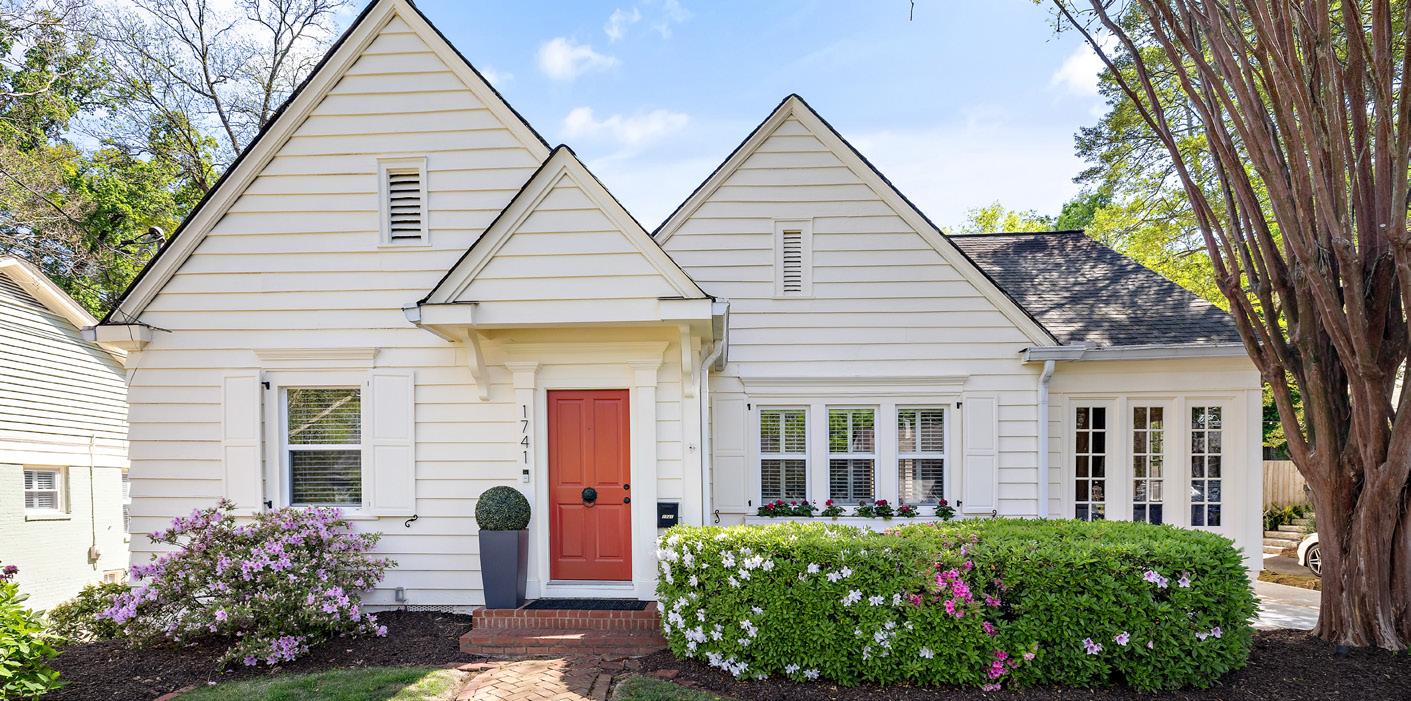


Continues on page 38
but the dust is settling. There are a lot of great opportunities for buyers out there searching for a condominium!”
Hall noted another issue that potential condo sellers are facing. “Many of the high-rise condo buildings that were completed between 2004 and 2007 are experiencing some normal, but expensive, age-related scheduled maintenance,” he said.
“The average days on market are up to 60, while the months of inventory is 4½, which is a more normal environment,” Hall continued. “If we look at the luxury market, homes sold over $1 million, we still have positive numbers with a 12% increase in inventory, 15% up in sales year over year and days on market averages of 67.”
Oliver expects the Intown market to remain largely the same. “As long as inflation remains as stubborn as it is and mortgage rates remain high, there isn’t the catalyst we need to spark significant change,” he said.
Strohschein expects inventory will remain at lower than balanced market levels, and more buyers entering the
market will keep the market competitive.
“Our population is still growing and for people moving in from states where real estate is much more expensive, Atlanta is very affordable,” Strohschein said. “Investing is also desirable in Atlanta for many in-state and out-of-state investors. I think this will continue to drive up prices.” If interest rates go down, Hall expects the market to loosen up a little bit. “It’s very hard to part with 3-4% interest rates, so people are staying put to renovate and upgrade. But, from 2023 to 2024, inventory is actually up 37% and sales are up 30%, but pending sales are now down 12%,” he reported.
While that number sounds like a lot, Hall explained it’s because the numbers are actually small. “It doesn’t feel like an uptick,” he said. “And factoring in more people moving to Atlanta, you can see the challenge.”
Hall stated that markets don’t like uncertainty and presidential elections years are usually a little slower. “However, I expect things to remain steady and mostly stable. The days on market might be a little longer, but that’s not an indication of value, just a return to a normalized market,” he said.
















 By Jan Schroder
By Jan Schroder
Tourists have been flocking to Western North Carolina for centuries, attracted by the mountain scenery, hiking trails and hundreds of waterfalls. Luxury inns cater to these visitors with all-inclusive gourmet meals, hiking guides, spas, golf courses and upscale but relaxed accommodations.
Here are three of my favorites where I discovered a love for winter hiking, felt soothed by a sound healing/yoga class, watched an unofficial parade of classic cars, sharpened my badminton skills, lazed in front of a wood-burning fire and watched the sun rise over four mountain ranges.
The Swag
2300 Swag Road Waynesville, North Carolina 28785 theswag.com
“Prepare for joy,” our yoga/sound healing teacher Barb said during our class. It was a lovely sentiment; however, I’d been in a permanent state of joy from the moment we walked into the Welcome Cabin at The Swag.
Located on 250 acres at an elevation of 5,000 feet, The Swag, a Relais and Châteaux property, consists of several buildings made with rough-hewn logs. There are 17 unique rooms in cabins and lodges, some with outdoor showers or tubs, indoor saunas and fireplaces.
We stayed in Will’s Room in Chestnut Lodge where we had an outdoor shower and a wood-burning fireplace. The front porch had a table where we ate lunch one day and rocking chairs perfect for taking in the mountain views.
The property shares a one-mile border with Smoky Mountain National Park so it was easy to grab our walking sticks and hit the trails. Adding to the charm of the property are hideaways where you can lie in a hammock by a stream or relax at a mountain overlook.
Other activities include cocktail classes, wine tastings, croquet, corn hole, fly

fishing, spa treatments, horseback riding and classes with their Experts-in-Residence program. Naturalists, artists, photographers and storytellers visit for a short time and host classes and lectures. During our visit, professional hiking guide Matt Dobson shared his tales from the trails and led us on a nature hike, sharing the area’s history and pointing out a 300-year-old cherry tree.
In addition to its stunning natural beauty and amazing service, a highlight of The Swag and the feature that elevated it to the top of our favorite places was the food. The resort is all-inclusive with little opportunity to build up an appetite, but we didn’t let that stop us.
Breakfast includes items like a breakfast sandwich, French toast, build your-ownomelet and a chef’s special. Lunch items like sandwiches and Thai chicken salad are selected the day before and packed in a backpack, bag or picnic basket. A highlight was the Chef’s Picnic on Gooseberry Knob, a huge grassy area where we feasted on burgers, salmon and fried chicken.
Dinner is a four-course meal with soup, salad, entrees like filet, Artic char and mushroom risotto, and dessert.
At the top of my list of favorite activities are hiking in the woods, dining outdoors with a water view and relaxing in a hot tub. I got to do all of these at Historic Tapoco Lodge, tucked into the Nantahala National Forest.
A former boarding house for workers of the Tallassee Power Company, Tapoco opened in 1930 and has six lodge rooms, three lodge suites and 18 cabin rooms on 120 acres on the Cheoah River. There’s a small spa, free yoga classes and tennis courts.
One afternoon we hiked one of the several trails with views of the Cheoah River, remains of an old moonshine still and a rapid elevation change that got our heartrates pumping.
An unexpected treat was the unofficial car show. Tapoco is located just minutes from Tail of the Dragon, an 11-mile stretch of U.S. 129 with 318 curves that attracts
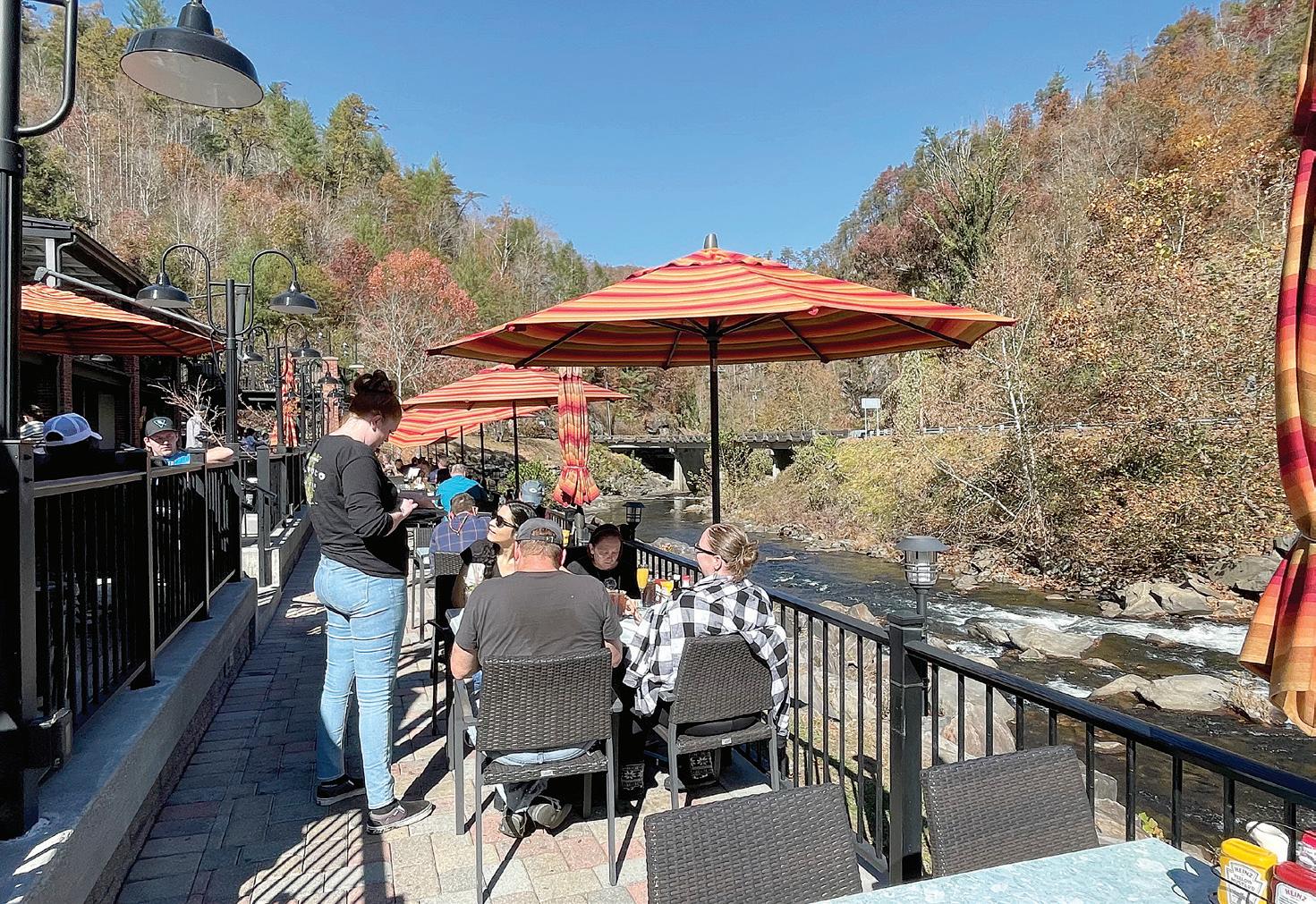
car enthusiasts who drop in for a drink or a meal, leaving their immaculately restored classic cars in the parking lot.
“The food alone is worth a return visit,” my husband Chris said as he bit into his black and blue burger at the Tapoco Tavern as we sat on the huge deck area overlooking the rushing river. Dinner that night was just as delicious and included a ribeye, grilled Carolina trout and fried okra.
High Hampton Resort 1525 Highway 107 S Cashiers, North Carolina 28717 highhampton.com
After the team behind Blackberry Farm purchased the 101-year-old High Hampton and reopened it in 2021, the “Dirty Dancing” vibe is gone along with the buffet meals and rustic dining room furnishings. Meals are now seated and the former allinclusive feature is optional. Along with the Dining Room and The Tavern in the inn, there are three other dining venues: Halsted House, Range House and Mitch’s Lakeside.
High Hampton maintains its vibe of laidback luxury with rocking chairs on the front porch, a huge lobby with a four-sided fireplace and several game tables. We checked out a board game and my husband beat me at “Mystery Date.”
The 1,400-acre property includes a Tom Fazio-designed golf course, lake, pool, children’s activity center, croquet lawn, spa, fitness room, hiking trails and six pickleball courts. Activities on the 35-acre lake in the warm weather include swimming, canoeing, paddle boarding and kayaking.
Accommodations include 18 inn rooms, 40 cottage rooms and three cottages. Our room in the inn had a balcony overlooking the lake, mini fridge, a huge bathroom with a bathtub and two sinks. The dark paneled hallways are lined with historic photos and pages from the original hotel registry books from decades ago.













